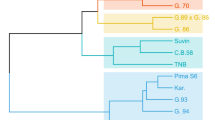Abstract
Improving fiber quality properties of cotton is important for increasing the efficiency of manufacturing textiles, including enhancing yarn quality and spinning performance. This study was conducted to determine if we could identify valuable cotton cultivars to use as parents in breeding programs with the goal of improving fiber properties. Seven parents were combined in a diallel design and selfed to obtain 21 F2 populations. Positive general and specific combining ability effects were observed for all traits. General combining ability tended to be larger than specific combining ability, indicating these traits are controlled primarily by additive genetic effects. Correlations among traits were generally positive except for lint yield correlations with fiber strength and length. For improving the fiber quality measures of strength and length, line 7235 shows excellent general combining ability effects. SG125 would provide elite germplasm to increase agronomic measures of lint yield and lint percent. The MD51 genotype has the highest potential among the genotypes tested here to provide germplasm combining both improved yield and fiber strength. These parents, or their selected progeny, should be useful in a breeding program to generate variability from which selection can be used to identify lines with improved fiber and/or agronomic properties.
Similar content being viewed by others
References
Bird LS (1979) Registration of Tamcot CAMD-E cotton. Crop Sci 19:411–412
Bowman DT, Gutierrez OA, Percy RG, Calhoun DS, May OL (2006) Pedigrees of Upland and Pima cotton cultivars released between 1970 and 2005. Miss Agric For Exp Stn Bull 1155
Braden CA, Smith CW (2004) Fiber length development in near-long staple upland cotton. Crop Sci 44:1553–1559
Braden CA, Smith CW, Hequet HF (2009) Combining ability for fiber length in near-long-staple upland cotton. Crop Sci 49:756–762
Bridge RR, Meredith WR, Chism JF (1971) Comparative performance of obsolete varieties and current varieties of upland cotton. Crop Sci 11:29–32
Constable GA, Ried PE, Thomson NJ (2001) Approaches utilized in breeding and development of cotton cultivars in Australia. In: Jenkins JN, Saha S (eds) Genetic improvement of cotton: emerging technologies. Science Publishers, Enfield, pp 1–16
Culp TW, Harrell DC (1975) Influence of lint percentage, boll size, and seed size on lint yield of upland cotton with high fiber strength. Crop Sci 15:741–746
Deussen H (1992) Improved cotton fiber properties—the textile industry’s key to success in global competition. In: Proceedings cotton fiber cellulose conference, Savannah, GA, 28–31 Oct 1992. National Cotton Council, Memphis, pp 43–63
Griffing B (1956) Concept of general and specific combining ability in relation to diallel crossing systems. Aust J Biol Sci 9:463–493
Guo WZ, Zhang TZ, Ding YZ, Zhu YC, Shen XL, Zhu XF (2005) Molecular marker assisted selection and pyramiding of two QTLs for fiber strength in upland cotton. Acta Genetica Sinica 32:1275–1285
Hinze LL, Kohel RJ, Campbell BT, Percy RG (2011) Variability in four diverse cotton (Gossypium hirsutum L.) germplasm populations. Genet Resour Crop Evol 58:561–570
Jenkins JN, McCarty JC, Wu J, Gutierrez OA (2009) Genetic variance components and genetic effects among eleven diverse upland cotton lines and their F2 hybrids. Euphytica 167:397–408
Kohel RJ, Richmond TR, Lewis CF (1970) Texas marker-1: description of a genetic standard for Gossypium hirsutum L. Crop Sci 10:670–671
Meredith WR (1984) Quantitative genetics. In: Kohel RJ, Lewis CF (eds) Cotton, Agron Monogr 24. ASA, CSSA, and SSSA, Madison pp 131–150
Meredith WR (1993) Registration of ‘MD51ne’ cotton. Crop Sci 33:1415
Miller PA, Rawlings JO (1967) Selection for increased lint yield and correlated responses in upland cotton, Gossypium hirsutum L. Crop Sci 7:637–640
Perkins HH, Ethridge DE, Bragg CK (1984) Fiber. In: Kohel RJ, Lewis CF (eds) Cotton, Agron Monogr 24. ASA, CSSA, and SSSA, Madison pp 437–509
Smith CW, Braden CA, Hequet EF (2010) Genetic analysis of fiber length uniformity in upland cotton. Crop Sci 50:567–573
Ulloa M (2006) Heritability and correlations of agronomic and fiber traits in an okra-leaf upland cotton population. Crop Sci 46:1508–1514
Woodward WTW, Malm NR (1976) Influence of lint percentage on yield, boll, and fiber characteristics in acala strains of upland cotton. Crop Sci 16:594–596
Wu J, McCarty JC, Jenkins JN, Meredith WR (2010) Breeding potential of introgressions into upland cotton: genetic effects and heterosis. Plant Breeding 129:526–532
Zeng L, Meredith WR (2009) Associations among lint yield, yield components, and fiber properties in an introgressed population of cotton. Crop Sci 49:1647–1654
Zhang T, Yuan Y, Yu J, Guo W, Kohel RJ (2003) Molecular tagging of a major QTL for fiber strength in Upland cotton and its marker-assisted selection. Theor Appl Genet 106:262–268
Zhang Y, Kang MS, Lamkey KR (2005) DIALLEL-SAS05: a comprehensive program for Griffing’s and Gardner-Eberhart analyses. Agron J 97:1097–1106
Acknowledgments
This research project was supported by funding from CRIS No. 6202-21000-031-00D of the U.S. Department of Agriculture. The authors gratefully acknowledge Shizhou (Shirley) Wang, Jared Harris, and Kelsey Hoegenauer for their invaluable technical assistance. Mention of trade names or commercial products in this publication is solely for the purpose of providing specific information and does not imply recommendation or endorsement by the U.S. Department of Agriculture.
Author information
Authors and Affiliations
Corresponding author
Rights and permissions
About this article
Cite this article
Hinze, L.L., Todd Campbell, B. & Kohel, R.J. Performance and combining ability in cotton (Gossypium hirsutum L.) populations with diverse parents. Euphytica 181, 115–125 (2011). https://doi.org/10.1007/s10681-011-0442-x
Received:
Accepted:
Published:
Issue Date:
DOI: https://doi.org/10.1007/s10681-011-0442-x




